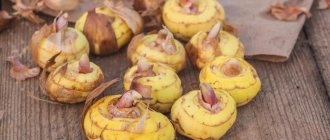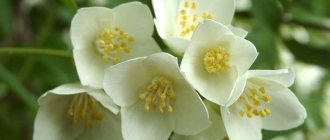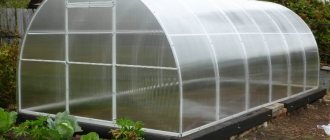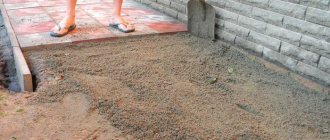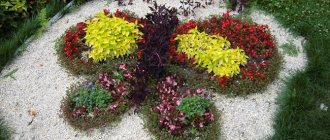It probably doesn’t make sense to talk in length and detail about what vaccination is and why it is needed. Anyone who is at least a little familiar with gardening knows very well that grafting is perhaps the fastest way to propagate cultivated plants, and sometimes the only one. When propagating varieties and hybrid forms, all the qualities of the mother plant can be transmitted only by vegetative means. But not all plants reproduce by cuttings and layering. So, the vaccine remains. In this article I’ll tell you what you should do in the winter in order to thoroughly prepare for spring vaccinations.
Getting ready for spring vaccinations
Why not propagate cultivated apple trees by sowing seeds?
It would seem that sowing seeds is the easiest way to propagate apple trees. Sow and wait until it sprouts and bears fruit. But the wait in this case will last a very long time: apple trees produce their first harvest after about the 5th year of growth, and only if the tree has been replanted at least three times before.
If the apple tree has not been replanted during its entire growth period, wait for the first harvest in the 15th year of growth.
Based on this, another question arises: what is special here? I replanted the apple tree three times and that’s it, wait for the first apples in the fifth year. But even here it’s not so simple. Any seed fruit crops do not inherit parental characteristics. This statement also applies to apple trees. So, when you grow a crop this way, you always leave a huge amount of intrigue because you don’t know what you’ll get in the end. You can spend a lot of time growing, but end up with completely inedible fruit, although very attractive in appearance.
Although there are exceptions to any rule. In this case, the exception is a group of old, but quite edible folk apple varieties. They are now planted much less frequently than new breeding varieties, but this does not make them any worse. The advantages of such varieties are durability and excellent adaptability to any growing conditions, but the disadvantages are the large height of the trees (difficult to care for) and the late date of fruiting.
So, to make the work easier, experienced gardeners advise the shortest way to an apple harvest - grafting onto wild animals.
Application practice
The budding method is convenient and effective.
If the grafting rules are followed, the survival rate of the scion is almost 100 percent. Therefore, the method is widely used.
Budding an apple tree to wild allows you to give the cultivated variety additional qualities, for example, winter hardiness or drought resistance. Sweet, aromatic varieties of southern apples can successfully grow and develop in rather harsh conditions.
In this way, zoned varieties are obtained.
Budding is used in the production of planting material. Growing apple tree seedlings by budding takes only one year. In addition, this grafting method allows you to grow planting material not only during the warm planting season, but also in winter.
Although this type of grafting is mainly used on young seedlings up to three years old, it is possible to budding an adult apple tree . Especially if the fruits have become smaller or fruiting has decreased. Grafting the same variety will help rejuvenate the tree.
Different varieties of apple trees can be grafted into the crown of an adult tree .
This is very convenient if you want to try to grow new varieties, but space on the plot is limited. TIP: There are limitations when grafting different varieties onto the same tree. It is desirable that the growth rates of the rootstock and scion coincide .
This discrepancy can make the survival of apple tree buds on rootstocks of a different species unsuccessful.
You can grow different varieties of apple trees on one tree.
The compatibility of apple and pear trees during budding has been confirmed not only theoretically, since both plants are pome-bearing, but also practically.
Many gardeners successfully graft an apple tree onto a pear tree and vice versa. This procedure can serve two purposes:
- Using pear exclusively as a rootstock;
- Getting a tree that grows apples and pears at the same time.
However, well-established vaccinations eventually disappoint summer residents.
IMPORTANT! The growth rate of pear trees significantly exceeds the development rate of apple trees. Abundant fruiting does not occur; after 3-7 years the graft dies off.
Rowan rootstock is often the basis for grafting small-fruited apple trees. It is used to reproduce different types of china. This combination gives good results.
Small-fruited apple trees and mountain ash are similar in growth rates . Budding an apple tree onto rowan increases the winter hardiness of the seedling. In addition, rowan rootstock makes it possible to reduce the height of the usually tall china.
Grafting large-fruited apple trees onto rowan is short-lived.
By studying the methods of how apple and pear grafting should be carried out (budding), you can significantly expand the capabilities of your orchard.
When is the most effective time to vaccinate wild animals?
The procedure requires a strong and good wild game, which will absorb all the nutritional compounds from the ground through its root system:
- Spring grafting is done when the buds have not yet begun to bloom, but the frosts have definitely passed and will not return. This time usually falls in March. The second time the procedure is carried out when the active movement of juices begins on the rootstock (this is approximately April - May). This time is considered the most successful, since the vaccinations take root and adapt well.
- If for some reason the grafted tree does not take root in the spring, then another grafting can be done in the summer. For this purpose, the graft must be prepared either in late autumn or early spring (by the time of grafting it will still be dormant). The procedure is carried out from the middle to the end of the summer season (late July - late August), when the trees begin the second period of active movement of sap. For the scion, you need to take the branches and buds that have developed in the current season.
- In the fall, grafting should be carried out so that the apple tree still has time for normal preparation for wintering. So, the best time to carry out the procedure will be the beginning of September, since further the movement of juices will begin to slow down and will end with the falling of leaves and, accordingly, hibernation. And the scion must have time to adapt to new conditions during this time, or it will die.
For autumn grafting, you need to cut off a cutting from a shoot, the length of which will reach 40 cm and the age of one year.
Preparing the rootstock for grafting
Let's start with the rootstock. Sometimes in a gardener’s practice it becomes necessary to completely regraft an existing plant (well, you don’t like the variety), or to graft several branches of a different variety or even varieties into the crown to improve pollination and fruiting. Although, in my opinion, the best option is to grow a seedling and graft it.
Right now, in winter, it is worth sowing the seeds of many crops so that they undergo stratification and sprout in the spring. Of course, you shouldn’t graft on a tiny seedling; you need to wait a year, or better yet, two. Allow the seedling to grow stronger and acquire a powerful root system.
How to grow a wild apple tree for grafting
If you already have a wild fruit tree somewhere on your property, then you can safely use it. However, if you do not have such a resource, you will have to grow it yourself.
Growing wild game from seeds yourself
For this growing method, you will need seeds of frost-resistant apple trees that grow specifically in your area (this is important!).
- You need to collect seeds in the fall; choose the largest fruits to collect seed.
- Rinse the seed and dry it.
- During the period from January 15 to 25, it is necessary to stratify the seeds. Cover them with sand and put them in the refrigerator.
- You can also sow seeds in the garden at a depth of 30–40 mm in autumn. Then they will be covered with snow all winter, and in the spring they will sprout. By autumn you will receive healthy and strong seedlings.
Introduction
Cuttings for grafting
Many gardeners believe that any parts of varietal plants can be used as grafting material, as long as they are healthy and do not have obvious signs of damage. Unfortunately, it is not.
There are many nuances at each stage of working with a scion: from the selection of material to its direct placement on the rootstock. If you make a mistake even in some small detail, you may not expect good results.
The article describes how to properly prepare grafting material, what you should pay special attention to, and what mistakes you should avoid. Despite the relative simplicity of the process, it requires constant attention and concentration, since the gardener will have a second chance in case of errors or deviations from the technology only in the next season.
The nuances of the procedure in different seasons
You need to prepare the scion in the fall, cutting off the branches after the first frost, and also cutting them into segments. In such cuttings, sap flow is slow, so they practically do not experience stress from pruning.
For the scion, choose branches 20–30 cm long with at least 5–6 buds. Such cuttings should be stored indoors at a temperature of 0 degrees, placing them in damp sand. The sand needs to be moistened periodically as it dries.
Spring grafting
This time is considered the most effective for grafting: 1. The “split” grafting procedure is carried out before the active movement of juices in the tissues of the tree begins.
2. The “bark” grafting method, as well as budding with a germinating eye, improved copulation and “butt” are best suited for grafting when the juices begin to flow.
Summer grafting
In the summer, the second period of active sap flow begins, so it is possible to graft a cultivated variety onto a wild apple tree “by the bark”, “into the cleft”, by budding with a sleeping eye, by improved copulation and “in the butt”. In the middle zone of the country, it is best to carry out budding in mid-summer (around the end of July), and for the southern regions, mid-late August is suitable.
Autumn procedure
In autumn, the effectiveness of grafting is not as high as in spring or summer.
However, if the warm weather in the region is delayed, then you can try budding in early to mid-September). You can also use the “butt” method or perform an improved copulation (not for beginners). It is advisable to complete the grafting with budding approximately 14–21 days before the onset of stable +15 outside. Adult plants are not grafted at this time. In the southern regions, vaccination is also possible in October.
About skill and ability
Many will give up, but, I assure you, there is nothing complicated about vaccination! It won’t work out the first time, but still... I’ll give you one piece of advice. It's winter outside, there are still 2-3 months before vaccinations. Cut branches of different thicknesses and on long winter evenings in a warm house, master and polish the technology of grafting. Learn to make even and smooth cuts in one motion. Have you already bought a good knife?
Why is this article called “Preparing for spring vaccinations”? There is plenty of time: to prepare cuttings, to buy tools and materials, and to acquire skills. But if it works out, how much pride you will feel! And what new opportunities will open up for you! I wish you success!
What is needed for the grafting process
To complete the procedure, you will need a whole set of tools that any self-respecting gardener should have:
- a knife with a short but sharply sharpened blade;
- grafting knife;
- budding knife;
- pruning shears (or hacksaw for wood).
It is also advisable to purchase a special grafting pruner. Models of grafting pruners may have different configurations, number of blades and cutting method. Advantages of the grafting pruner:
- much lower level of injury compared to conventional tools;
- allows you to make shaped cuts so that the coincidence of the cut parts is absolute;
- allows you to make the most accurate and thin sections for budding.
Tools and materials
For high-quality grafting, you need to buy a high-quality grafting knife. You can argue for a long time which is better - a grafting knife or a grafting pruner, but note that professionals usually use a knife.
An ordinary kitchen knife or pocket knife is not entirely suitable for these purposes. As a rule, their blade is not hard and sharp enough, but the cut must be made as evenly as possible and in one movement, then the rootstock and scion will match perfectly.
To keep your blade sharp, you will need a whetstone, preferably one with two different grits.
It is also worth remembering that for different types of grafting you will need knives of different shapes, as well as high-quality sharp pruning shears and a garden saw. Do not neglect disinfecting the instrument; alcohol or vodka are quite suitable for this. A fungal infection introduced into the wound can negate all your efforts and, moreover, destroy the plant. Clean the blade of the grafting knife before each cut.
In order to tightly connect the scion and rootstock, you need to stock up on a special elastic strapping tape. Electrical tape or strips cut from polyethylene bags are not so convenient. Modern tapes fix the grafting site well and break down on their own over time.
In order to avoid the evaporation of precious moisture from the cuttings and rootstock, all cut areas should be coated with garden putty, preferably with a fungicidal effect, or, as a last resort, use garden pitch or even plasticine.
A sharpening stone to maintain the sharpness of the blade and a special elastic band for grafting. © Igor Bilevich
What care do grafted trees need?
The graft wrapped in elastic material should be inspected and checked every 14 days. You can also, if necessary, loosen the strapping somewhat so that it does not grow into the tree bark. It is necessary to protect the operation site from birds and pinch shoots throughout the summer.
For an apple tree that was grafted in the spring or summer, the bandage is removed after 60 days, but for a wild apple tree that was grafted in the fall, the bandage is removed in the spring, when all the snow has melted.
When the graft adapts, the buds will wake up and shoots will begin to form from them. There is no need to leave them all, choose only the strongest one (usually the top one).
At the end of July - beginning of August, remove the tips of the shoots on the cuttings. This will help stop the intensive growth of the cuttings in length and stimulate growth in width. In addition, this technique will help speed up the fusion of the scion and rootstock. Those shoots that grow below the graft need to be cut off (they only take away nutrients from the cutting).
It is also necessary to tie the regrown shoots to the support:
- this should be done for the first time when they grow by 20–25 cm;
- the second time the procedure is carried out when they reach a length of 40–50 cm.
A grafted wild bird needs regular watering and feeding in the summer.
General rules for cutting cuttings
- Select a healthy mother tree (3 to 10 years old) of your desired variety that bears fruit well.
- Cut cuttings from annual shoots that are located on the well-lit side of the crown. Remember, cuttings taken from the south side of the central part of the crown take root best.
- Do not take cuttings from thin shoots with poorly developed buds, as well as from crooked, damaged branches and tops.
- Hold the selected shoot suspended and cut 30-40 cm cuttings with a well-sharpened knife or pruning shears.
- The cuttings should be as thick as a pencil (about 7 mm in diameter).
- Do not touch the cuttings with your hands, otherwise the cuttings will not take root well or, even worse, you may get an infection.
Harvesting cherry cuttings has its own characteristics. There are a lot of buds on the annual shoots of this plant, so you need to choose those branches with fewer buds and cut cuttings 65-70 cm long.
Storing cuttings in winter - what you need to remember
Once the cuttings are cut, tie them into bundles and hang labels on them (cardboard labels covered with tape or wooden signs are suitable for this) with the names of the tree varieties. This way you will definitely not confuse the planting material.
When saving cuttings for grafting, remember that they should not freeze or dry out. Also, rodents should not reach them. But just in case, prepare more cuttings than you plan to use, because they may not “survive” the winter in full force.
It is very important to clearly know how to store cuttings so that they survive until grafting. There are several methods - choose the one that is available to you.
Storing cuttings in the snow
If snow cover persists all winter in your region, you can safely store the cuttings in the snow. Dig a small trench (hill) 30-35 cm deep, cover it thickly with spruce branches, lay out the cuttings, and cover it again with pine needles. The final touch is to cover it with earth, sawdust or straw, and when snow falls, throw it on top. Keep in mind that the thickness of the snow cover above the hidden cuttings should be about 50 cm.
To prevent rodents from encroaching on the cuttings, wrap the planting material with fiberglass or ordinary nylon tights
Storing cuttings outside in frozen sawdust
This method of storing cuttings is suitable for western and southwestern regions with prolonged thaws. Choose a location on the north side of the site and sprinkle a sufficient amount of wet sawdust on the ground. Place the cuttings on them, and also sprinkle a layer of wet sawdust on top. This “fur coat” should be in the cold. Then cover it with a 40-centimeter layer of already dry sawdust. The top layer is polyethylene.
Sawdust retains moisture well and thereby creates an environment favorable for storing cuttings
To protect the cuttings from rodents, you can moisten the sawdust not with water, but with a solution of carbolic acid (50 g per 10 liters of water). Mice and rats will not like this “aroma”.
Storing cuttings in the cellar
Place the lower ends of the chopped and sorted cuttings in sawdust (place bundles of cuttings with the cuts down in a plastic bag and sprinkle with wet sawdust without tying it up) or in sand (place the cuttings in a wooden box with small holes and fill their lower part with wet sand). To prevent the cuttings from becoming moldy or dry out, make sure that the temperature in the cellar is from 0 to 1°C and the humidity is between 65-70%.
Cuttings must be stored at a temperature of 0 to 1°C
When storing grape cuttings, the temperature should be from 1 to 4°C. In such conditions, the chibuki will last well until mid-March.
An important condition is maintaining normal substrate humidity. How to determine the degree of moisture? Squeeze the substrate lightly in your hand - if it is damp, but no water drips from it, everything is fine.
Storing cuttings in the refrigerator
The most uncomplicated way of storage. But, as a rule, in such conditions, the grafting material is stored no longer than until the end of February - in March the buds “wake up”.
Place bunches of cuttings in a plastic bag, pre-wrapped with a damp cloth, and place in the refrigerator. If it is possible to regulate the temperature, set the value no higher than 2°C.
When storing cuttings, it is important to ensure that they are sufficiently moistened
Unusual ways to store cuttings
If you are smart, you can find a few more places where the cuttings will last until spring. For example, some gardeners wrap the cuttings in a clean plastic bag or put them in a plastic bottle and hang them on a balcony, veranda, outside the window of a city apartment, or on a tree growing near the house. The main thing is that there is a suitable temperature and humidity for the cuttings.
